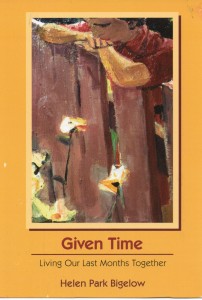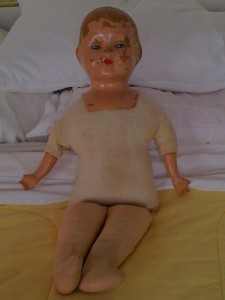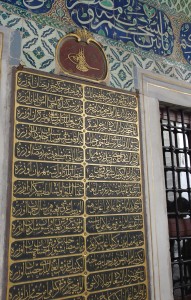Archive for May, 2014
The Doll
As a child, I was a trial to my mother. Throw epithets at me and I’ll own them: mean, resentful, difficult. I was jealous of my sister Evelyn, one year older than me. She was the beautiful one, with the blue eyes and golden ringlets my mother adored, the one with the heirloom china doll with its own blue eyes and golden hair, handed down from some relative or other.
Another word: ungrateful. That describes me this week, when an email from my youngest sister Alison arrived. She and my other sister, Patricia, had been doing a spot of spring-cleaning and had found my childhood doll. Did I want it? No, I replied, flooded with guilt about that unloved “child.”
A memory. I am maybe five or six. I am lying on my parents’ bed, sobbing and sobbing. I have been put there on time out for fighting with my cousin. Lee was a few months younger than me. She was then an only child, with parents who doted on her. Lee had a fancy new baby doll. Evelyn had the exquisite china doll. We played mothers and babies, but all I had for a baby was a yellow knitted creature of indeterminate parentage. I picked a fight. Lee and I came to blows. Time out. I sobbed at being hauled in from play, at the unfairness of life.
The door opens and Lee creeps in.
“What do you want?” Surly, still angry.
“I know a secret. You’re not supposed to know. Your Dad’s fixing Sally.” Sally was another heirloom, a celluloid baby doll so fragile she was constantly on Dad’s workbench with a broken limb.
An adult arm reaches through the half-open door and drags Lee out. It gives me satisfaction to hear her being slapped and scolded. A few minutes later my mother appears. “You might was well come out, then. It was supposed to be a surprise.”
Dad’s repair to Sally lasts no longer than usual. But at least I have a glimmer that someone cares. For my birthday I receive a large package from my parents. It is a doll who can close her eyes in sleep. But not a beautiful doll. She looks like me: straight dark hair cut into bangs like mine, brown eyes, a tiny mouth, her features molded in some coarse composition material. I play with her, of course, but do not cherish her.
Seventy years later, the doll’s portrait shows up in my email in-box. Where on earth has she been all these years, I ask my sisters. It turns out they found her among the effects of our eldest sister, Evelyn, who died several years ago. Had Evelyn kept her safe all these years? Or had she rescued her from our mother’s cluttered house when she helped move Mum into an assisted living apartment? We’ll never know. But it humbles me to think that both of them cared enough to keep the doll safe when her oblivious “mother” abandoned her.
The doll is now officially an antique, sister Pat tells me. She’s somewhat the worse for wear. Her hair is gone. It looks like she’s fallen on her face a few times. I feel a rush of tenderness for the forlorn creature she has become. I’ve asked my sisters to find her a good home.
Given Time
 Given Time: Living Our Last Months Together by Helen Park Bigelow, which I’ve just finished reading, is an unflinching look at the emotional and physical landscape a care-giving spouse or partner must traverse in those last months before death. Helen’s husband Ed had a melanoma removed in 2005. The surgery seemed successful, and regular follow-up tests and scans at first came out clear. But three years later the melanoma returned and metastasized throughout his body.
Given Time: Living Our Last Months Together by Helen Park Bigelow, which I’ve just finished reading, is an unflinching look at the emotional and physical landscape a care-giving spouse or partner must traverse in those last months before death. Helen’s husband Ed had a melanoma removed in 2005. The surgery seemed successful, and regular follow-up tests and scans at first came out clear. But three years later the melanoma returned and metastasized throughout his body.
To offer a flavor of the book, I can’t do better than to quote the blurb by Fithian Press, the book’s publisher: “The book deals honestly with the process of dying, an ordeal shared by both of them. It also deals with the process of staying alive and in love until the ordeal is over… [Bigelow] writes with brutal honesty about her anger and grief over what has become of her husband and herself. The book isn’t a manual about how to take care of a dying man, but it makes the reader well aware of what a grueling job it is. “So this is it,” she writes. ‘This chemo routine is the rest of our lives together…and goddamn it, it’s going to be as good for both of us as I can make it.’ ”
Reading this book set me to thinking about my husband’s and my circle of friends. We’re all of an age where we’re facing mortality, both our own and our partners’. Physical infirmities creep up on us. Memories start to fail. The mechanisms of the heart become clogged. I know we’ll all do what we have to do, to the best of our abilities, when loved ones need our care, and that, if we are the ones whose lives are ending, we hope to have someone as caring as Helen to tend our passage. I’m grateful that services such as hospice are available. Most of all, I am inspired by Helen’s love of beauty to seek it out in my own life. Whether my time is counted in decades or years or even months, I want every day to be touched by grace.
Word Art
I spent this morning thinking about the intersection of writing and art — how we can be moved by a piece of art that involves words, even when the writing is undecipherable. Or when you are ignorant of the language, as I was recently in Istanbul, where I was captivated by the Arabic script that decorated walls of mosques and palaces.
Last night was the opening celebration in Mendocino for the show “Boundless: Art of Letter, Word and Book,” which curator Janet Self describes as a “hands-on conversation about art, language, books, and engagement in the modern age.” I have several pieces in the show: a poem collaged onto a cast paper fish, the poetry box from my vegetable garden, a handmade book that employs a complex flower-fold structure (suggested by Alisa Golden in “Making Handmade Books”), plus some broadsides and tiny chapbooks.
As I looked around the room, I saw uses of the written word that sparkled with creativity. Janet has posted some pictures on her Flockworks blog site. Among my favorites were “House of Cards,” a walk-in house shape whose walls were linked postcards from all over the world, sent years ago to members of the same family, and inherited by the house-maker. I chatted with Harry Van Ornum, a calligraphy student who, having filled his practice paper with lyrics by a favorite singer, turned the paper sideways and continued, making of the words an abstract form. Janet Self, faced with a huge collection of her father’s Reader’s Digest Condensed Books that no thrift store would take, repurposed the pages into large, flowing geometric sculptures.
My favorite encounter was with a young man who stood entranced in front of a calligraphic painting by the late Jim Bertram, one of the artists who helped found the Mendocino Art Center in the 1960s. It was part of a collection being sold as a fund-raiser for Flockworks, the tiny nonprofit that creates such community art projects as the “Boundless” show.
“Excuse me,” he said. “Can you tell me if that calligraphy is in some language?”
Having met and written about Jim Bertram not long before he died, I was able to tell the young man that no, the beautiful shapes were not words. I told him about the quote I found while researching this artist: Line expresses the inner thought. It is a narrative of what we really want to tell each other but somehow can’t seem to verbalize.
“Now I really want that painting,” the young man responded. “I don’t have any money. But next payday, I’m coming back to buy it.”

